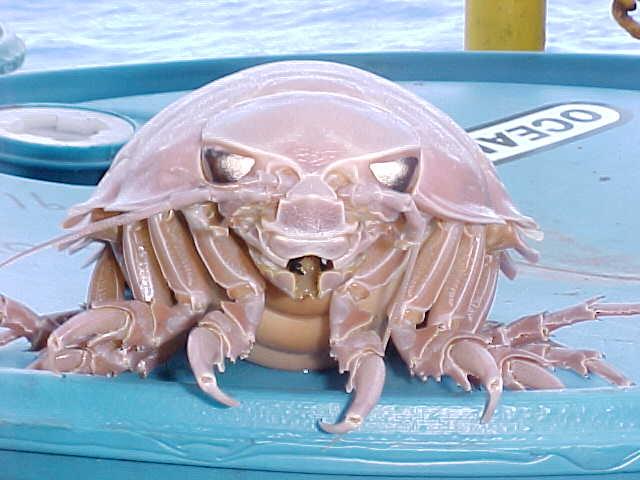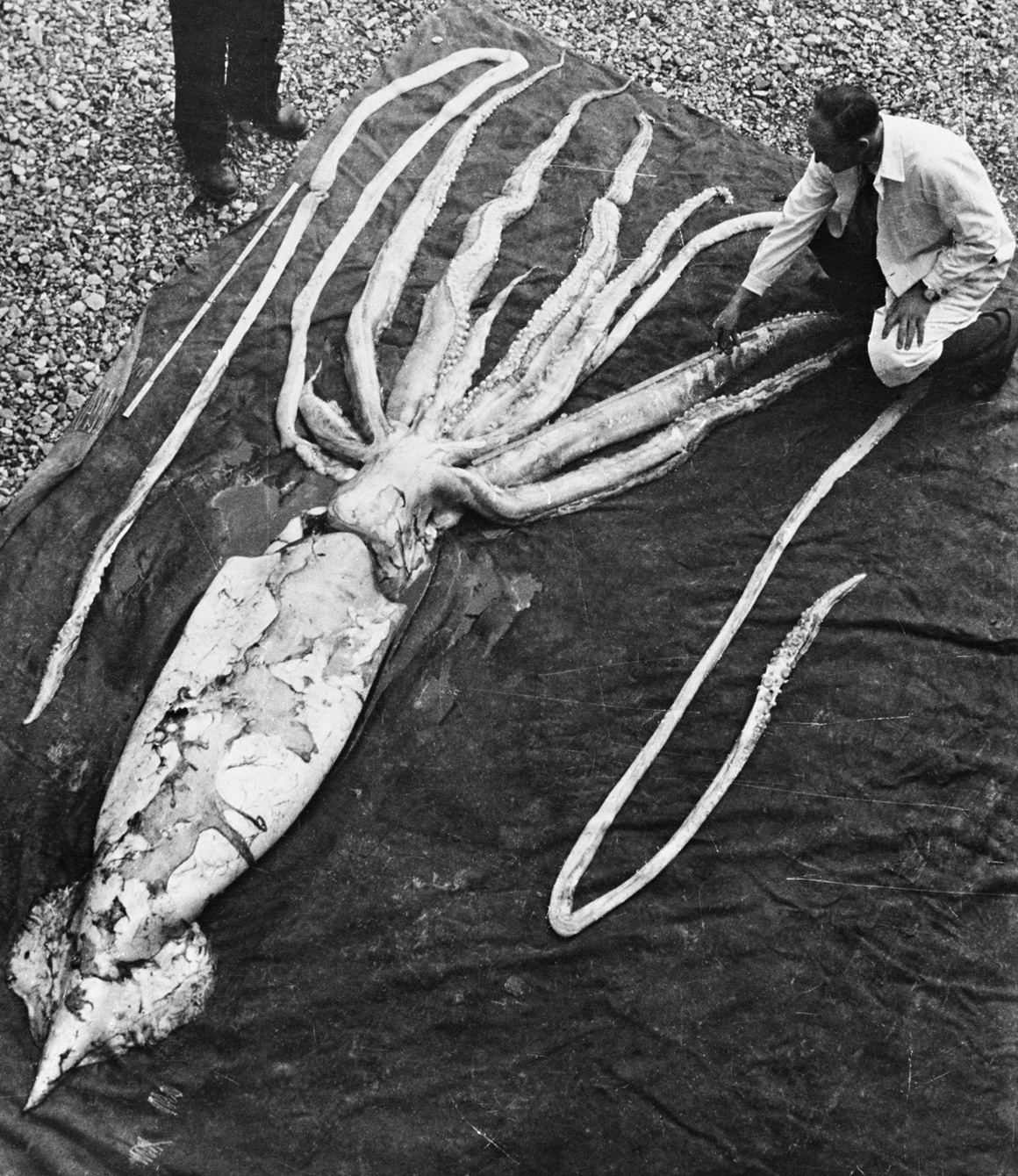|
Deep Sea Creature
The term deep sea creature refers to animals that live below the photic zone of the ocean. These creatures must survive in extremely harsh conditions, such as hundreds of bars of pressure, small amounts of oxygen, very little food, no sunlight, and constant, extreme cold. Most creatures have to depend on food floating down from above. These creatures live in very demanding environments, such as the abyssal or hadal zones, which, being thousands of meters below the surface, are almost completely devoid of light. The water is between 3 and 10 degrees Celsius and has low oxygen levels. Due to the depth, the pressure is between 20 and 1,000 bar. Creatures that live hundreds or even thousands of meters deep in the ocean have adapted to the high pressure, lack of light, and other factors. Evolutionary adaptations of deep-sea creatures Lack of light The lack of light requires creatures to have special adaptations to find food, avoid predators, and find mates by creating their ow ... [...More Info...] [...Related Items...] OR: [Wikipedia] [Google] [Baidu] |
Photosynthesis
Photosynthesis is a process used by plants and other organisms to convert light energy into chemical energy that, through cellular respiration, can later be released to fuel the organism's activities. Some of this chemical energy is stored in carbohydrate molecules, such as sugars and starches, which are synthesized from carbon dioxide and water – hence the name ''photosynthesis'', from the Greek ''phōs'' (), "light", and ''synthesis'' (), "putting together". Most plants, algae, and cyanobacteria perform photosynthesis; such organisms are called photoautotrophs. Photosynthesis is largely responsible for producing and maintaining the oxygen content of the Earth's atmosphere, and supplies most of the energy necessary for life on Earth. Although photosynthesis is performed differently by different species, the process always begins when energy from light is absorbed by proteins called reaction centers that contain green chlorophyll (and other colored) pigments/chromoph ... [...More Info...] [...Related Items...] OR: [Wikipedia] [Google] [Baidu] |
Woods Hole, Massachusetts
Woods Hole is a census-designated place in the town of Falmouth in Barnstable County, Massachusetts, United States. It lies at the extreme southwest corner of Cape Cod, near Martha's Vineyard and the Elizabeth Islands. The population was 781 at the 2010 census. It is the site of several marine science institutions, including Woods Hole Oceanographic Institution, the Marine Biological Laboratory, the Woodwell Climate Research Center, NOAA's Northeast Fisheries Science Center (which started the Woods Hole scientific community in 1871), the Woods Hole Science Aquarium, a USGS coastal and marine geology center, and the home campus of the Sea Education Association. And the headquarter of the Climate Foundation. It is also the site of United States Coast Guard Sector Southeastern New England (formerly USCG Group Woods Hole), the Nobska Light lighthouse, and the terminus of the Steamship Authority ferry route between Cape Cod and the island of Martha's Vineyard. History Histor ... [...More Info...] [...Related Items...] OR: [Wikipedia] [Google] [Baidu] |
Woods Hole Oceanographic Institution
The Woods Hole Oceanographic Institution (WHOI, acronym pronounced ) is a private, nonprofit research and higher education facility dedicated to the study of marine science and engineering. Established in 1930 in Woods Hole, Massachusetts, it is the largest independent oceanographic research institution in the U.S., with staff and students numbering about 1,000. Constitution The Institution is organized into six departments, the Cooperative Institute for Climate and Ocean Research, and a marine policy center. Its shore-based facilities are located in the village of Woods Hole, Massachusetts, United States and a mile and a half away on the Quissett Campus. The bulk of the Institution's funding comes from grants and contracts from the National Science Foundation and other government agencies, augmented by foundations and private donations. WHOI scientists, engineers, and students collaborate to develop theories, test ideas, build seagoing instruments, and collect data in diverse ... [...More Info...] [...Related Items...] OR: [Wikipedia] [Google] [Baidu] |
DSV Alvin
''Alvin'' (DSV-2) is a crewed deep-ocean research submersible owned by the United States Navy and operated by the Woods Hole Oceanographic Institution (WHOI) in Woods Hole, Massachusetts. The vehicle was built by General Mills' Electronics Group in Minneapolis, Minnesota. Named to honor the prime mover and creative inspiration for the vehicle, Allyn Vine, ''Alvin'' was commissioned on 5 June 1964. The submersible is launched from the deep submergence support vessel , which is also owned by the U.S. Navy and operated by WHOI. The submersible has made more than 5,000 dives, carrying two scientists and a pilot, to observe the lifeforms that must cope with super-pressures and move about in total darkness, as well as exploring the wreck of ''Titanic''. Research conducted by ''Alvin'' has been featured in nearly 2,000 scientific papers. Design ''Alvin'' was designed as a replacement for bathyscaphes and other less maneuverable oceanographic vehicles. Its more nimble design was made ... [...More Info...] [...Related Items...] OR: [Wikipedia] [Google] [Baidu] |
ALVIN Submersible
Alvin may refer to: Places Canada *Alvin, British Columbia United States *Alvin, Colorado *Alvin, Georgia *Alvin, Illinois * Alvin, Michigan *Alvin, Texas *Alvin, Wisconsin, a town *Alvin (community), Wisconsin, an unincorporated community Other uses * Alvin (given name) * Alvin (crater), a crater on Mars * Alvin (digital cultural heritage platform), a Swedish platform for digitised cultural heritage * Alvin (horse), a Canadian Standardbred racehorse * 13677 Alvin, an asteroid * DSV ''Alvin'', a deep-submergence vehicle * Alvin, a fictional planet on ''ALF'' (TV series) * Alvin Seville, of the fictional animated characters Alvin and the Chipmunks * "Alvin", by James from the album ''Girl at the End of the World'' * Tropical Storm Alvin See also * Alvin Community College * Alvin High School * Aylwin (other) Patricio Aylwin (1918–2016) was a Chilean politician. Aylwin may also refer to: *Andrés Aylwin (1925–2018), Chilean politician * Guy Maxwell Aylwin (1889– ... [...More Info...] [...Related Items...] OR: [Wikipedia] [Google] [Baidu] |
Human
Humans (''Homo sapiens'') are the most abundant and widespread species of primate, characterized by bipedalism and exceptional cognitive skills due to a large and complex brain. This has enabled the development of advanced tools, culture, and language. Humans are highly social and tend to live in complex social structures composed of many cooperating and competing groups, from families and kinship networks to political states. Social interactions between humans have established a wide variety of values, social norms, and rituals, which bolster human society. Its intelligence and its desire to understand and influence the environment and to explain and manipulate phenomena have motivated humanity's development of science, philosophy, mythology, religion, and other fields of study. Although some scientists equate the term ''humans'' with all members of the genus ''Homo'', in common usage, it generally refers to ''Homo sapiens'', the only extant member. Anatomically moder ... [...More Info...] [...Related Items...] OR: [Wikipedia] [Google] [Baidu] |
Lantern Shark
''Etmopterus'' is a genus of lantern sharks in the squaliform family Etmopteridae. They are found in deep sea ecosystems of the Atlantic, Indian and Pacific Oceans. Ecology A number of species in this genus function as host to the specialized parasitic barnacle ''Anelasma squalicola'', which embeds itself into the skin of the shark and extracts nutrients from its bloodstream. Species There are currently 45 recognized species in this genus: * ''Etmopterus alphus'' Ebert, Straube, Leslie & Weigmann, 2016 (whitecheek lanternshark) * ''Etmopterus baxteri'' Garrick, 1957 (New Zealand lanternshark) * ''Etmopterus benchleyi'' Vásquez, Ebert & D. J. Long, 2015 (ninja lanternshark) * ''Etmopterus bigelowi'' Shirai & Tachikawa, 1993 (blurred lanternshark) * ''Etmopterus brachyurus'' H. M. Smith & Radcliffe, 1912 (short-tail lanternshark) * '' Etmopterus brosei'' Ebert, Leslie & Weigmann, 2021 * '' Etmopterus bullisi'' Bigelow & Schroeder, 1957 * '' Etmopterus burgessi'' S ... [...More Info...] [...Related Items...] OR: [Wikipedia] [Google] [Baidu] |
Tube Worm (body Plan)
A tubeworm is any worm-like sessile invertebrate that anchors its tail to an underwater surface and secretes around its body a mineral tube, into which it can withdraw its entire body. Tubeworms are found among the following taxa: * Annelida, the phylum containing segmented worms ** Polychaetea, the class containing bristle worms *** Canalipalpata, the order containing bristle-footed annelids or fan-head worms **** Siboglinidae, the family of beard worms ***** ''Riftia pachyptila'', a species known as giant tube worms ***** Lamellibrachia, a genus **** Serpulidae, a family **** Sabellidae, the family containing feather duster worms * Phoronida, the phylum containing horseshoe worms * Microconchida, an order of extinct tubeworms * ''Kuphus polythalamia ''Kuphus polythalamius'' is a species of shipworm, a marine bivalve mollusc in the family Teredinidae. Description The tube of ''Kuphus polythalamius'' is known as a crypt and is a calcareous secretion designed to enable the animal ... [...More Info...] [...Related Items...] OR: [Wikipedia] [Google] [Baidu] |
Pill Bug
Armadillidiidae is a family of woodlice, a terrestrial crustacean group in the order Isopoda. Unlike members of some other woodlice families, members of this family can roll into a ball, an ability they share with the outwardly similar but unrelated pill millipedes and other animals. This ability gives woodlice in this family their common names of pill bugs or roly polies. Other common names include slaters, potato bugs, doodle bugs and cheeselogs. Most species are native to the Mediterranean Basin, while a few species have wider European distributions. The best-known species, ''Armadillidium vulgare'', was introduced to New England in the early 19th century and has become widespread throughout North America. Ecology and behavior Pill bugs in the family Armadillidiidae are able to form their bodies into a ball shape, in a process known as '' conglobation''. This behaviour is shared with pill millipedes (which are often confused with pill bugs), armadillos, and cuckoo wasps. I ... [...More Info...] [...Related Items...] OR: [Wikipedia] [Google] [Baidu] |
Giant Isopod
A giant isopod is any of the almost 20 species of large isopods, crustaceans distantly related to shrimp and crabs, which are decapods, in the genus ''Bathynomus''. They are abundant in the cold, deep waters of the Atlantic, Pacific, and Indian Oceans.Lowry, J. K. and Dempsey, K. (2006). ''The giant deep-sea scavenger genus Bathynomus (Crustacea, Isopoda, Cirolanidae) in the Indo-West Pacific.'' In: Richer de Forges, B. and Justone, J.-L. (eds.), Résultats des Compagnes Musortom, vol. 24. Mémoires du Muséum National d’Histoire Naturalle, Tome 193: 163–192. '' Bathynomus giganteus'', the species upon which the generitype is based, is often considered the largest isopod in the world, though other comparably poorly known species of ''Bathynomus'' may reach a similar size (e.g., ''B. kensleyi''). The giant isopods are noted for their resemblance to the much smaller common woodlouse (pill bug), to which they are related. French zoologist Alphonse Milne-Edwards was the first ... [...More Info...] [...Related Items...] OR: [Wikipedia] [Google] [Baidu] |
Deep-sea Gigantism
In zoology, deep-sea gigantism or abyssal gigantism is the tendency for species of invertebrates and other deep-sea dwelling animals to be larger than their shallower-water relatives across a large taxonomic range. Proposed explanations for this type of gigantism include colder temperature, food scarcity, reduced predation pressure and increased dissolved oxygen concentrations in the deep sea. The inaccessibility of abyssal habitats has hindered the study of this topic. Taxonomic range In marine crustaceans, the trend of increasing size with depth has been observed in mysids, euphausiids, decapods, isopods and amphipods. Non-arthropods in which deep-sea gigantism has been observed are cephalopods, cnidarians, and eels from the order Anguilliformes. Examples of deep-sea gigantism include the big red jellyfish, the giant isopod, giant ostracod, the giant sea spider, the giant amphipod, the Japanese spider crab, the giant oarfish, the deepwater stingray, the seven-arm ... [...More Info...] [...Related Items...] OR: [Wikipedia] [Google] [Baidu] |
.jpg)




